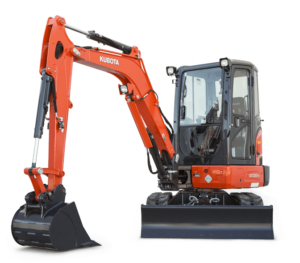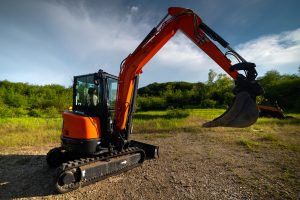Mini excavators are versatile, powerful, and essential tools for construction projects, landscaping, and ambitious DIY tasks. Their compact size and maneuverability make them favorites for tackling jobs in tight spaces, from digging trenches to clearing debris.
But mastering a mini excavator requires skill and practice. Whether you’re a contractor aiming to improve your efficiency, a landscaper prioritizing precision, or a DIY enthusiast taking on your first project, these tips will help you operate a mini excavator safely and effectively.
What this guide covers: 
- An overview of mini excavators’ capabilities
- Safety essentials for operators
- How to master the controls
- Pro digging techniques
- Maintenance tips to keep your machine in top condition
By the end of this guide, you’ll be prepared to take full control of your mini excavator while staying safe and efficient.
Safety First: Essential Operating Tips
Operating a mini excavator can be risky without the proper precautions. Even experienced operators must follow safety guidelines to prevent accidents or equipment damage.
Inspect Your Equipment
Before every use, conduct a thorough inspection of your mini excavator. Check for signs of wear and tear, loose bolts, or leaks. Pay close attention to the tracks, hoses, and hydraulic connections.
Pro Tip: Always check the hydraulic fluid levels before operation. Low fluid levels can cause performance issues or equipment failure.
Wear Proper Safety Gear
Appropriate safety gear is non-negotiable. Always wear a hard hat, sturdy gloves, steel-toe boots, and a high-visibility vest to minimize on-site risks.
Survey the Worksite
Take a few minutes to assess the worksite. Are there slopes, mud, rocks, or obstacles? Working on uneven terrain requires careful planning. When navigating a slope, keep the boom and arm extended low for better stability and lower the blade to improve traction.
Common Mistake: Avoid driving across steep slopes to prevent tipping risks. Always move straight up or down.
Know the Load Limits
One of the most common operator errors is overloading the bucket. Exceeding the weight capacity could destabilize your mini excavator, lead to spills, or damage the hydraulic system. Always keep loads within the manufacturer’s recommended limits.
Mastering the Controls
Mini excavators are equipped with multiple controls, which can feel overwhelming to beginners. But with a little practice and patience, you’ll maneuver like a pro.
Familiarize Yourself with the Layout
Take some time to sit in the operator’s seat and identify the following controls:
- Joystick Controls: For operating the boom, stick, and bucket.
- Blade Control Lever: Used to raise or lower the dozer blade.
- Pedal and Levers: To rotate the cab and operate the tracks.
Most mini excavators come with user-friendly labels or diagrams to make it easy to learn the basic motions of each lever or pedal.
Practice Makes Perfect
Before starting a project, practice moving the boom, arm, and bucket in a safe, open space. Try rotating the cab, raising and lowering the blade, and driving the machine in different directions.
When you’re confident in handling the controls, start with smaller, simpler tasks like digging shallow trenches. Over time, you’ll develop the muscle memory to handle more complex movements.
Digging Techniques
Efficient digging is a skill that combines accurate control with smart planning. Use the following techniques to maximize productivity and reduce effort.
Plan Your Dig
Start by marking your work area with paint, stakes, or string. A clear plan reduces guesswork and ensures precise digging.
Use Pilot Holes in Hard Soil
When working in dense or compacted soil, create pilot holes to make digging easier. Use the bucket teeth to scrape the surface and loosen the area before scooping out larger chunks.
Digging on Slopes
Need to dig on a slope? Position the mini excavator with the blade facing uphill. This provides support for the tracks and improves stability during operation.
Pro Tip: Avoid over-reaching with your boom and bucket when digging on uneven terrain. Keep the workload close to the machine to maintain balance.
Working Around Obstacles
Mini excavators are perfect for tight spaces, but proximity to walls or objects can be a challenge. Use the smaller adjustments on the joystick controls to make slow, precise movements.
Maintenance and Care
Regular maintenance keeps your mini excavator operating at peak performance and extends its lifespan. After all, an idle or faulty machine costs both time and money.
Perform Daily Maintenance
At the start of each day, complete these maintenance checks:
- Inspect tracks for damage or debris buildup.
- Check hydraulic fluid, engine oil, and coolant levels.
- Clean the cab windows and mirrors for better visibility.
By addressing small issues immediately, you can avoid costly repairs down the road.
Regular Servicing
Schedule professional servicing based on the manufacturer’s recommended intervals. This often includes replacing filters, greasing fittings, and inspecting hydraulic systems.
Proper Storage
When not in use, store your mini excavator in a clean, dry area. If possible, use a weatherproof cover to protect it from rain and dust.
Maximize Your Mini Excavator Potential
Mastering a mini excavator isn’t just about knowing how to operate the levers or dig trenches; it’s about working strategically and with precision while prioritizing safety. By following these tips, you’ll be well-equipped to handle your next project confidently and effectively.
Are you looking for expert advice tailored to your specific project or equipment? Contact us today to speak with our experienced team. We’ll help you maximize your mini excavator’s potential and ensure you achieve the best results!



